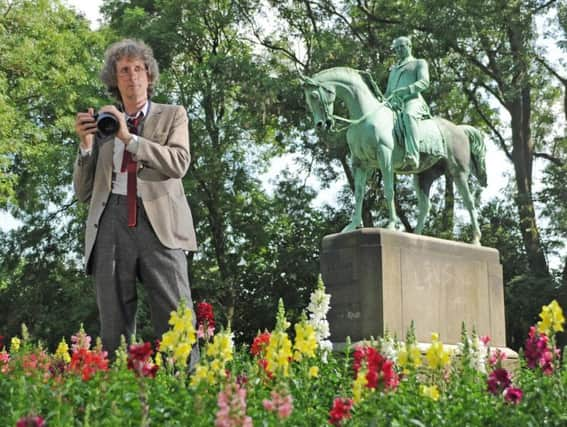Dean Clough director putting monuments and sculptors in the spotlight


From the statue of the Black Prince in Leeds City Square has grown an eclectic survey of four dozen Yorkshire sculptures.
The monument, which was unveiled more than a century ago, was the starting point for the survey, a photographic project which has inspired a no-punches-pulled book and an online ‘digital exhibition’.
Advertisement
Hide AdAdvertisement
Hide AdIt has been put together by Vic Allen, the Arts Director at Halifax’s Dean Clough and features statues, mostly erected to make the great and good look even greater and better, that range wide across Yorkshire and its achievements.
They take in Fred Trueman, Harold Wilson, Captain Cook, Dickie Bird, Amy Johnson, Philip Larkin, Billy Bremner, Constantine the Great, William Wilberforce... and, of course, The Black Prince.
The Monumental Oversights project started as a response to the current Yorkshire Sculpture International, which Allen felt under-represented the county’s own sculpture and sculptors.
“I’m against exclusivity,” he says. “I thought: Let’s bring public sculpture into this.”
Advertisement
Hide AdAdvertisement
Hide AdSo he set about “compiling dull images of the boring public statues which inhabit the county”. An odd self-recommendation but it’s irony, he says.
The project had a boost when Allen was giving the sculptor Michael Sandle a lift to Leeds station.
As they drove into City Square, Sandle said how much he admired the statue of the Black Prince. Allen was taken aback: “Despite knowing Leeds for over 45 years, I’d never consciously noticed it before then.”
Talking to other artists, it emerged that they’d noticed as little public sculpture as he had.
Advertisement
Hide AdAdvertisement
Hide Ad“Half of us never see the sculptures around us,” he says. “And if we do, we never think to question who they are or why they’re there.” He decided to remedy the situation.
Allen says the project “explores Yorkshire through some of its public sculptures” and includes statues of once-famous people who have been forgotten and people “who deserved to be famous” like Sheffield’s Women of Steel, who worked in the city’s armaments factories, and Hull’s Lost Trawlermen, the 6,000 lost at sea.
The pictures stand up in their own right, but the book’s commentary – aiming to “explore the politics of the public realm” – puts them in a predictably opinionated context.
Allen, who edited Yorkshire’s Artscene magazine for 15 feisty years, is not a man to risk bland predictability if controversy is a tastier option. Wiry, puckish, with a shock of curly hair, he’s a whirlwind of words, a tumult of thoughts.
Advertisement
Hide AdAdvertisement
Hide AdIdeas jump up and down when he’s talking and wave frantically for attention.
He’s clever, subversive, outspoken, full of attitude and wry amusement, and so critical that he even characterises his own book as “arbitrary and incomplete”, full of “snide remarks that conceal an awkward fondness” for the chosen statues and sculptures.
He has excluded war memorials, animal statues and shrines and is “consciously prejudiced against Queen Victoria statues, corporate statues and obvious high-art statements”.
He also takes a casual swipe at “Bradford’s Delius monument, the giant mesh packhorse in Leeds Trinity Centre, and the gift-shoppy seagulls at No 1 City Square.” So how did he choose which to include?
Advertisement
Hide AdAdvertisement
Hide AdThere were obvious candidates, he says.... the gleaming gold statue of “King Billy” (William of Orange) riding like a Roman emperor over an underground Hull public convenience.
Harold Wilson reaching for the pipe in his suit pocket as he hot-foots it from Huddersfield station.
Captain Cook in Whitby “overseen by the mouldering jaw of a Right Whale”.
And that haughty Leeds statue of the Black Prince, who had no apparent connection with the city.
Advertisement
Hide AdAdvertisement
Hide AdThere’s the Walking Man, the doggedly striding 1957 statue by miner’s son George Fullard outside Sheffield’s Millennium Galleries.
Allen notes with delight that on a previous site, the Walking Man was often seen with a cigarette stuck between his lips, a beer can under his arm and a traffic cone on his head. “Now you can’t do better than that,” he says.
Beyond all those, there’s the UK’s two largest standing stones – at Rudston near Bridlington and at Boroughbridge.
There are a fair few statues by Barnsley-based Graham Ibbeson and a Halifax statue of Prince Albert on his horse Nimrod.
Advertisement
Hide AdAdvertisement
Hide AdAnd there’s the row of figures on the balustrade of Harrogate’s Victoria Centre “sporting expressions that you only find in Ladybird books”.
There’s also the sober statue of the 19th century engineer Joseph Locke in Barnsley’s Locke Park. “
On the face of it, it’s a sculpture of a man holding his coat,” he says.
“It’s a dull statue, but the stories around it are terrific. He deserves at be as well known as Stephenson and Brunel.”
Visit www.ac-dc.org.uk, the Arts Charity at Dean Clough website, for the digital exhibition. The book, priced at £10, is available on Amazon or from Dean Clough.